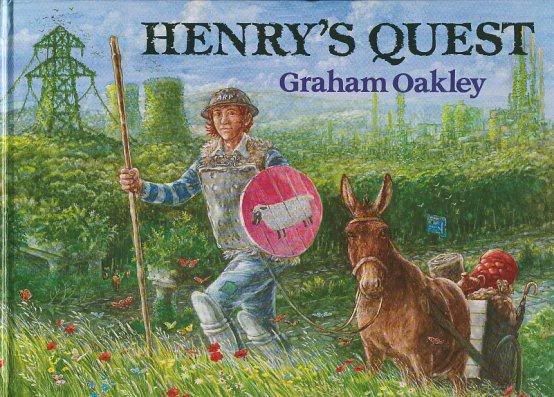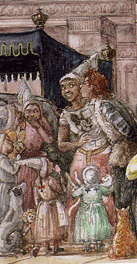Book Review: Graham Oakley’s Henry’s Quest
Occasionally when I visit my public library, I discover the most unexpected books sitting on the shelves. A few weeks ago, while helping to choose out some picture books, I chanced upon Henry's Quest, a children's book that imagines what life would be like in our world after peak oil.
 Henry's Quest
Henry's Quest
By Graham Oakley
Atheneum Publishers
New York, 1986
32 pages
ISBN 0-689-31172-9
In addition to being about life after oil, the book also features a multiracial English royal family. There is much to like about Henry's Quest, so if you have any children in your life or just like amazing illustrations, then please continue on to read my book review.
This book is a work of fiction and I won't pretend it accurately predicts what life is going to be when we run out of oil. The dust jacket blurb explains "Henry's Quest takes a wry look at our belief's, our times and a possible future. At the same time, it is a funny tale — one full of wisdom." This is a pretty good description of the book.
Graham Oakley is gentle and subtle with his humor. Often the joke will be in the picture accompanying the story rather than be in the text itself. The pictures are all in color and have interesting details throughout. For example, in the forest surrounding the kingdom are rusting automobile frames and abandoned household appliances; the jousting knights ride on bicycles and mules, and in town, what was once the chemist's shop (pharmacy) is now the herbalist.
The story takes place in the future and is set in a small country, which is ruled by King Arthur II.
One day, when the king was still only a very small prince, he found two books. They had been used to prop up the back of the nursery cupboard and so when, years before, the prince's great-great-great grandfather had ordered the burning of all books to improve the minds of his people, they had been overlooked.
One of the two surviving books was King Arthur and the Knights of the Round Table. When the prince became the king, he changed his name to Arthur and had hundreds of copies of the book made so all his subjects could read it. The kingdom soon was enthralled by chivalry and tales of knight errantry. So, when it came time for the king's eldest daughter to be married, he issued a proclamation declaring the successful suitor will be chosen by means of a Quest.
Henry, a young shepherd, was intrigued by two things in life — his flock of sheep and the only other book in the kingdom: Aunty Mabel's Fairy Tale Book. Henry had read much in that book about caves full of treasure and winning the hand of a princess and thought he'd like to give the latter a try. So he went to see the king. Henry met the king and the entire royal family in "the king's private museum."
As with most of Oakley's illustrations, the picture of the royal family is filled with surprises and little details. The royal family is multiracial and the king is a man rich in daughters. The royal museum appears to be in a department store and the most notable family heirlooms are "shiny objects" (automobiles) that have been in the family since the "Old Days". The king then gives Henry the quest:
...he went on to say that he believed that GASOLINE† still lurked about somewhere, either in the forest or beyond, and that the purpose of the Quest was to find it and bring it back alive. If Henry could do that, Arthur said, he would be a knight worth of a place at the Round Table and the Princess Isolde would be his bride.
Princess Isolde looked as if she definitely liked he idea and the queen looked as if she definitely didn't. Henry just smiled sheepishly and blushed.
† In the British edition of Henry's Quest, I expect GASOLINE would instead be PETROL.
So the following day, Henry and "a bunch of rather well-to-do knights" set out seeking gasoline. Through several pages of pictures, Oakley shows where Henry journeys along his quest. Oakley's imaginative illustrations captures what life could be like in post peak oil Britain on his quest. One of the places he visits is an overgrown Esso oil refinery and a fort built into an overhead powerline tower structure.


Other places Henry visits as he travels on his quest is a village living in the ruins of a jumbo jet, a gas station that has been converted into a cow barn, a zoo where the wild animals now roam free, and the crumbling highway system.
I found Oakley's depiction of post peak oil highways interesting. The roadway is in a state of disrepair. Weeds and trees are growing in the cracked and crumbling roadbed. The overpasses and bridges have collapsed and highway signage has rusted beyond use. Plying the ruined roads are traders on great flatbed semi trailers. The flatbeds are rigged with a square sail and pulled by a team of horses. They built up like an 16th century sailing ship and guarded to protect the goods from bandits.
Henry's quest eventually takes him to a great city where gasoline still lurked. The smokestacks in the city belch black clouds of smoke and surrounding the city walls are piles of abandoned automobiles and household appliances. The city is ruled by the emperor as a police state. The citizens are kept amused by the imperial lottery, discos, taverns, casinos, bingo parlors, night clubs and more. Henry arrives in the middle of a riotous protest in which the citizens are demanding importing things such as "stronger beer" and "bigger bingo prizes". Henry is swept up in the protesting crowd and is rounded up by the police when the armored "Crowd Pacification Unit 13" arrives on the scene. He is then taken to the emperor:
...the emperor seemed quite a nice chap and almost had good manners. He was very keen to hear all about Henry's homeland and asked if it was very rich; if it had strong walls around it; if it had a powerful army and if Henry could tell him exactly how to find it. Henry's answers were respectively yes, no, no and no, he'd lost his sense of direction, upon which the emperor went slightly purple and shouted that thumbscrews would probably restore it pretty quickly. But he soon got a grip on himself...
Henry then tells the emperor of his quest for gasoline and the emperor tells him that he has plenty of gasoline and will personally accompany him to the Imperial Gasoline Repository and present him with some gasoline of his own. Plus the emperor would send two of his most trusted servants to assist Henry in bringing the gasoline back to his homeland. Interestingly, Oakley depicts the gasoline repository full of oil drums with USA and USAF stenciled on them.
 I will end my story synopsis here as not to totally spoil the ending, but it shouldn't surprise anyone that Henry and Princess Isolde do live together "very happily every after".
I will end my story synopsis here as not to totally spoil the ending, but it shouldn't surprise anyone that Henry and Princess Isolde do live together "very happily every after".
I think there is much to like in Henry's Quest. I find it incredible that Oakley wrote and illustrated this book over 21 years ago in 1986. I think Oakley's premonitions about our possible post-peak oil future to be realistically possible. I really liked his royal family (they reappear at the end of the story) and think his illustrations are rich with details and wonderful. I enjoyed Oakley's wry and ironic sense of humor especially when he skillfully combines his 'straight man' narrative with his 'punch line' illustrations.
While this book may be difficult to find since it is out-of-print, I think it is worth the effort to seek out from your local library or used book dealer. Henry's Quest was ahead of its time and with our world facing the increasing likelihood of peak oil, I think Oakley's extraordinary book is an excellent way to introduce the concept of life without oil with our children. I highly recommend Henry's Quest.


